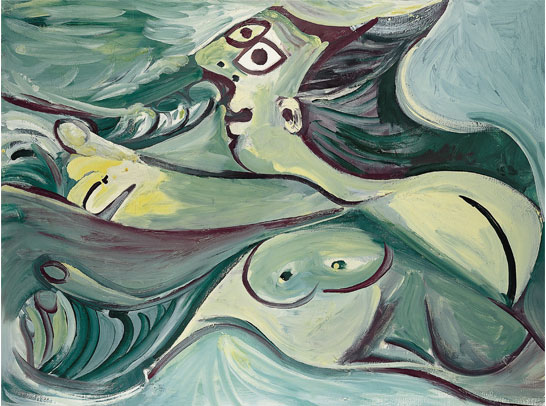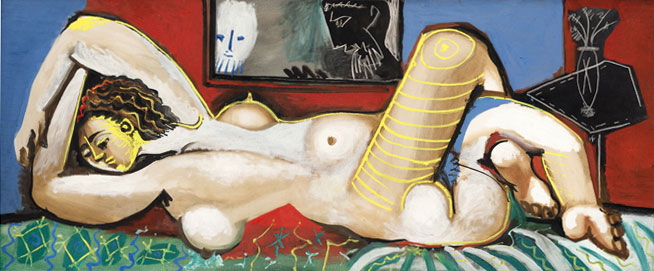Pablo Picasso (1881-1973). Susanna and the Elders. Nice, summer 1955. Fundación Almine y Bernard Ruiz-Picasso para el Arte,
Madrid. On temporary loan to the Museo Picasso Málaga © FABA photo: Hugard & Vanoverschelde Photography
© Sucesión Pablo Picasso, VEGAP, Madrid, 2020MUSEO PICASSO MÁLAGA
Palacio de Buenavista C/ San Agustín, 8
29015 Málaga, Spainhttps://www.museopicassomalaga.org/en
By periodically refreshing, and thus revising, its permanent collection, Museo Picasso Málaga is in a way following in the footsteps of Picasso himself, who innovated constantly with his art throughout his life. With its thematic and chronological layout, this new exhibition narrative in the Palacio de Buenavista will enable visitors to acquire a deeper knowledge of Pablo Picasso’s artistic career by grouping his works together in a way that helps them to understand his artistic processes. This is the sixth transformation of the exhibition rooms of the Palacio de Buenavista since the museum first opened in 2003, thanks to the negotiations that took place to ratify the agreement between the Consejería de Cultura y Patrimonio de la Junta de Andalucía and Fundación Almine y Bernard Ruiz-Picasso para el Arte (FABA), which has been renewed for three more years, during which time a total of 162 works by Picasso will be added to the 233 works MPM holds in its own collection.
The new layout of the exhibition rooms owes its unique features to an innovative scenographic layout in the museum spaces. There are 44 paintings, 49 drawings, 40 graphic works, 10 sculptures, 17 ceramics, 1 tapestry and 1 linocut plate. With the 233 works belonging to Museo Picasso Málaga and these 162 from Fundación Almine y Bernard Ruiz-Picasso para el Arte (FABA), the collection will hold almost four hundred works by Pablo Picasso, dating from between 1894 and 1972, of which 120 will be on display in the Palacio de Buenavista. These works build a story that begins with Picasso’s formative years and continues through the most representative periods of the artist’s career.
 |
| Pablo Picasso (1881-1973). Gallery II of the new route Dialogues with Picasso at the Museo Picasso Málaga © Museo Picasso Málaga © Succession Pablo Picasso, VEGAP, Madrid, 2020 |
| For the exhibition presentation associate curator Pepe Karmel, who devised the exhibition concept, explained his point of view as follows: "The challenge in displaying the work of Pablo Picasso is to do justice to his astonishing diversity while also demonstrating the unity and coherence of his work. In just a few years, Picasso travelled from the drama and tenderness of the Blue and Rose Periods to the cerebral experiment of cubism. After the First World War, he invented a new, modern form of classicism. In the 1920s and ‘30s, he went back and forth among cubism, classicism and surrealism. After World War II, he invented new styles for which art historians have still not found names. He is best known as a painter but was also the greatest sculptor of the twentieth century. And the greatest printmaker To help the visitor to get to know Picasso, Karmel came up with the idea of displaying his work "in small groups of related pictures and sculptures. Each group is focused on a traditional subject such as the human body, the portrait, or the still life. One room is a “bestiary,” with paintings and sculptures of bulls, birds, and cats. There is also a rich selection of his narrative drawings, some illustrating Aristophanes’ bawdy comedy Lysistrata, others recounting the myth of the Minotaur.” |
![Pablo Picasso (1881-1973). Still Life with Guitar. Paris or Juan-les-Pins, [1920]. Fundación Almine y Bernard Ruiz-Picasso para el Arte, Madrid. On temporary loan to the Museo Picasso Málaga © FABA photo: Hugard & Vanoverschelde Photography © Sucesión Pablo Picasso, VEGAP, Madrid, 2020](/images/stories/musees/museo_picasso_malaga/picasso_still_life_h.jpg) |
| Pablo Picasso (1881-1973). Still Life with Guitar. Paris or Juan-les-Pins, [1920]. Fundación Almine y Bernard Ruiz-Picasso para el Arte, Madrid. On temporary loan to the Museo Picasso Málaga © FABA photo: Hugard & Vanoverschelde Photography © Sucesión Pablo Picasso, VEGAP, Madrid, 2020 |
| The new layout begins on the ground floor, introducing the visitor to the artist himself through photographs and biographical texts, then moves on to a series of Women and Men, with portraits dating from 1894 to 1906, then another on Cubism: bodies, with works from 1906 to 1914. Then Cubism: still lives, with works from 1911 to 1922, is shown in the same room as the selection Modern Classicism, dating from 1922-1923. The tour continues through Models, Bathers and Defiant Women, with works from 1927 to 1933, and the section Metamorphosis and Abstraction, from the 1927-1932 period. On the upper floor of the gallery, the exhibition continues with The Minotaur and Other Monsters, which contains a selection of works from 1928 to 1938, and Relentless Gazes, with portraits painted between 1934 and 1939. The Anatomy of Terror, with works dating from 1936 to 1948, and The Face of War, the Face of Peace, from 1944 to 1950, contain works from that convulsive period. Next, we move on to the Bestiary, with depictions of animals dating from 1941 to 1960, and the Carnal Landscapes of 1944 to 1971. With Picasso by now settled in the South of France, Return to the Mediterranean brings together works from 1948 to 1960, and leads to the room containing Familiar Gazes, portraits painted between 1962 and 1965, before ending with The Wise Child, with works from 1970 to 1972 - just a year before he died. |
 |
| Pablo Picasso (1881-1973). Bather. Mougins, 5. Museo Picasso Málaga. Gift of Christine Ruiz-Picasso © Museo Picasso Málaga. Photo: Rafael Lobato © Sucesión Pablo Picasso, VEGAP, Madrid, 2020 |
History of the Collection |
|
Museo Picasso Málaga was created in response to Pablo Picasso’s own desire for his work to be present in the city where he was born on 25 October 1881. The museum was created thanks to Christine and Bernard Ruiz-Picasso, the artist’s daughter-in-law and grandson, whose donations constitute the core of the Collection. It was also made possible thanks to the efforts of the Junta de Andalucía, which coordinated the major project of setting up a museum devoted to the artist whose styles and techniques changed the course of modern art. The initial idea for the museum arose in 1953, as a result of the contact between Pablo Picasso and Juan Temboury Álvarez, who was the Provincial Delegate for Fine Arts in Malaga. However, the project fell through shortly afterwards. Christine Ruiz-Picasso, the widow of the artist’s eldest son, Paul Ruiz-Picasso, resumed contact with Malaga in 1992, during the exhibition Picasso Clásico(Classic Picasso), and again in 1994, during the exhibition Picasso, primera mirada, (Picasso, the first glimpse). In 1996, she rekindled the 1953 project, which finally came into being 50 years later on 27 October 2003, when the museum was officially opened by Their Majesties King Juan Carlos I and Queen Sofía of Spain. There are 233 works in the MPM Collection. This group of works covers Picasso’s revolutionary innovations, as well as the wide range of styles, materials and techniques he mastered. From his earliest academic studies, to his personal take on the Classics; from the overlapping perspectives of Cubism, to his experiments in ceramics, and from his re-workings of the Old Masters, to his late paintings in the 1970s. |


